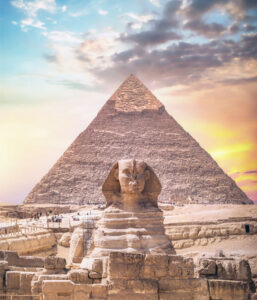The Giza Plateau, located on the outskirts of Cairo, Egypt, is one of the most renowned archaeological sites in the world. Home to the iconic Great Pyramids of Giza, the Sphinx, and various other ancient monuments, this site has captivated historians, archaeologists, and tourists for centuries. The Giza Plateau is not just a symbol of ancient Egyptian civilization but also a testament to human ingenuity and architectural prowess.
The Giza Plateau is most famous for the three great pyramids built during the Fourth Dynasty of Egypt’s Old Kingdom, around 2580–2560 BC. These pyramids were constructed as monumental tombs for the pharaohs Khufu (Cheops), Khafre (Chephren), and Menkaure (Mykerinos). The largest of these, the Great Pyramid of Khufu, is the only surviving wonder of the original Seven Wonders of the Ancient World.
The site also includes the Great Sphinx, a colossal limestone statue with the body of a lion and the head of a human, believed to represent Pharaoh Khafre. The Sphinx, shrouded in mystery, has intrigued scholars with its enigmatic expression and purpose.
The Great Pyramid of Khufu: Standing at approximately 146.6 meters (481 feet), it was the tallest man-made structure in the world for over 3,800 years. The pyramid’s precise alignment with the cardinal points and its construction using over 2.3 million stone blocks, some weighing as much as 80 tons, continues to baffle experts.
The Pyramid of Khafre: Slightly smaller than Khufu’s pyramid, this structure is unique due to its still-intact smooth casing stones at the top, offering a glimpse of how the pyramids originally appeared.
The Pyramid of Menkaure: The smallest of the three, Menkaure’s pyramid is accompanied by three smaller pyramids known as the Queen’s Pyramids. Despite its size, the intricate design and craftsmanship are no less impressive.
The Great Sphinx: Positioned to guard the Giza Plateau, the Sphinx is an enduring symbol of ancient Egypt. Measuring 73 meters (240 feet) long and 20 meters (66 feet) high, it remains the largest monolith statue in the world.
The Giza Plateau served as a sacred burial ground, reflecting the ancient Egyptians’ beliefs in the afterlife. The pyramids were designed not just as tombs but as complex religious structures meant to ensure the pharaoh’s safe passage to the afterlife. The orientation, scale, and intricacy of these structures underscore the Egyptians’ profound religious dedication and their advancements in mathematics and astronomy.
Today, the Giza Plateau is a UNESCO World Heritage Site and continues to be a major tourist attraction, drawing millions of visitors each year. The site is not only an essential part of Egypt’s cultural heritage but also a focal point for ongoing archaeological research. New discoveries continue to be made, offering fresh insights into ancient Egyptian society and the mysteries that have long surrounded this awe-inspiring site.
Visitors to the Giza Plateau can explore the pyramids, enter the tombs (subject to preservation restrictions), and witness the grandeur of the Sphinx up close. Guided tours offer in-depth knowledge about the history and significance of each monument, while the nearby Giza Solar Boat Museum showcases a meticulously preserved ancient boat used in royal funerals.
For an unforgettable experience, many visitors choose to view the plateau at sunrise or sunset, when the golden light casts dramatic shadows across the desert landscape, enhancing the majestic beauty of these ancient wonders.
